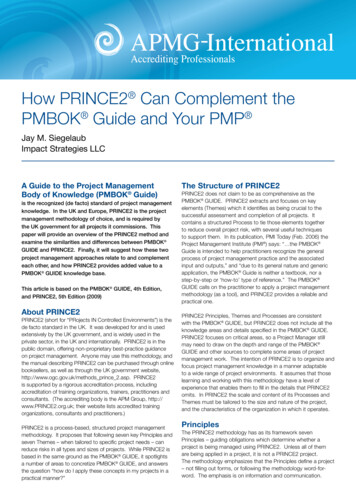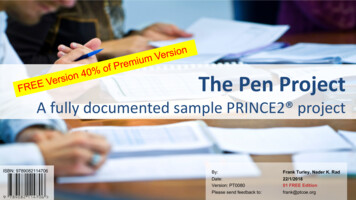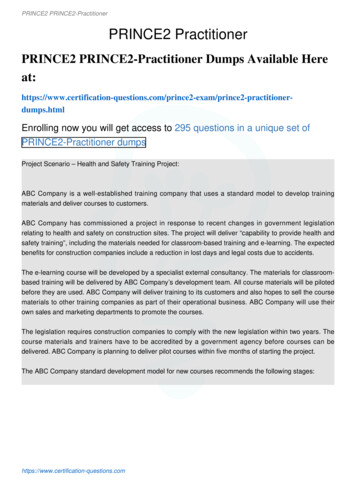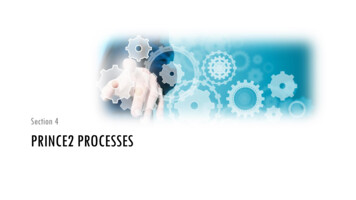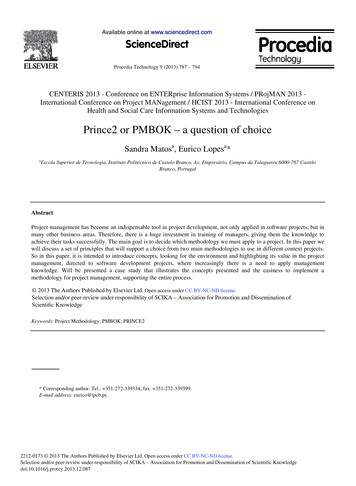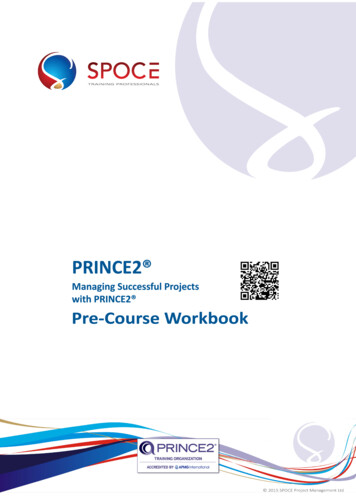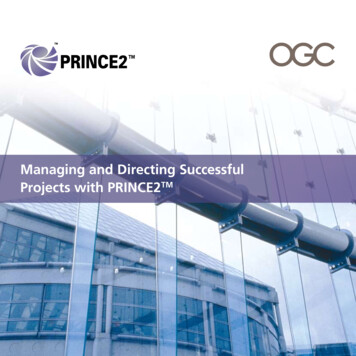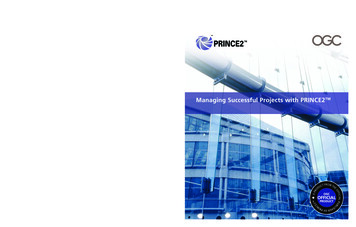
Transcription
It is often stated that the one constant in the modern worldis change. Whether that change is driven from a strategicperspective, forms part of a programme of transformationalchange, or is in response to an operational imperative, thedelivery mechanism for change remains the same, and that isproject management.Managing Successful Projects with PRINCE2TMThis latest version of the PRINCE2TM method has beendesigned to place more emphasis on the principles thatunderpin successful project management, and to provideclear guidance on how to apply these principles to theorganizational context within which projects are operating.As such, it is an essential manual for anyone with an interestin managing projects more successfully.The challenge that faces all organizations, whether they bepublic or private sector, large or small, is to deliver changethrough managing projects successfully and consistently.This is where the PRINCE2 project management method addsreal value, as the globally recognized standard for deliveringsuccessful projects.Managing Successful Projects with PRINCE2TMISBN 978-0-11-331059-3www.tso.co.uk5909 P2Managing V0 7.indd 19 780113 31059315/5/09 14:42:36
Managing Successful Projects with PRINCE2 London: TSO
Published by TSO (The Stationery Office) and available from:Onlinewww.tsoshop.co.ukMail, Telephone, Fax & E-mailTSOPO Box 29, Norwich, NR3 1GNTelephone orders/General enquiries: 0870 600 5522Fax orders: 0870 600 5533E-mail: customer.services@tso.co.ukTextphone 0870 240 3701TSO@Blackwell and other Accredited AgentsCustomers can also order publications from:TSO Ireland16 Arthur Street, Belfast BT1 4GDTel 028 9023 8451 Fax 028 9023 5401 Crown Copyright 2009Published on behalf of the Office of Government CommerceThis is a Crown copyright value added product, reuse of which requires a Licence from OGC.Applications to reuse, reproduce or republish material in this publication should be sent to OGC,The OGC Service Desk, Rosebery Court, St Andrews Business Park, Norwich, Norfolk, NR7 0HS.Tel No: ( 44) (0)845 000 4999, E-mail: servicedesk@ogc.gsi.gov.uk, or complete the applicationform on the OGC website, Licensing section.Copyright in the typographical arrangement and design is vested in The Stationery Office Limited.Applications for reproduction should be made in writing to The Stationery Office Limited,St Crispins, Duke Street, Norwich NR3 1PDThe Swirl logo is a Trade Mark of the Office of Government CommerceThe OGC logo is a Registered Trade Mark of the Office of Government Commerce in the United KingdomPRINCE is a Registered Trade Mark of the Office of Government Commerce in the United Kingdom andother countriesPRINCE2 is a Trade Mark of the Office of Government Commerce in the United Kingdom and othercountriesITIL is a Registered Trade Mark of the Office of Government Commerce in the United Kingdom and othercountriesM o R is a Registered Trade Mark of the Office of Government Commerce in the United Kingdom andother countriesMSP is a Trade Mark of the Office of Government CommerceP3O is a Registered Trade Mark of the Office of Government CommerceP3M3 is a Trade Mark of the Office of Government CommerceFirst edition Crown Copyright 1996Second edition Crown Copyright 1998Third edition Crown Copyright 2002Fourth edition Crown Copyright 2005Fifth edition Crown Copyright 2009First published 2009ISBN 978 0 11 331059 3Printed in the United Kingdom for The Stationery OfficeN6012442 c240 05/09
ContentsList of figuresviList of tablesviiiForewordxAcknowledgementsxiConventions used in this manual124xiii295.1Purpose315.2Organization defined315.3 The PRINCE2 approach 47The importance of projects36.2Quality defined47What makes projects different?36.3The PRINCE2 approach to quality496.4Responsibilities5711.1The purpose of this manual1.21.31.4 Why have a project managementmethod?41.5Introducing PRINCE241.6Related OGC guidance61.7Benefits of 79Plans597.1Purpose617.2Plans defined617.3The PRINCE2 approach to plans647.4Responsibilities722.1Continued business justification112.2Learn from experience122.3Defined roles and responsibilities128.1Purpose772.4Manage by stages138.2Risk defined772.5Manage by exception138.3The PRINCE2 approach to risk782.6Focus on products148.4Responsibilities88Tailor to suit the projectenvironment14Introduction to PRINCE2 themes153.1What are the themes?173.2Applying the themes183.3Format of the themes182.735Business Case194.1Purpose214.2Business Case defined219Risk75Change899.1Purpose919.2Change defined919.3The PRINCE2 approach to change929.4Responsibilities9610 Progress9910.1 Purpose10110.2 Progress defined10110.3 The PRINCE2 approach to progress 1024.3 The PRINCE2 approach to theBusiness Case224.427Responsibilities810.4 Responsibilities109
iv Contents11 Introduction to processes11118 Closing a Project11.1The PRINCE2 processes11318.111.2The PRINCE2 journey11318.2 Objective20511.3The PRINCE2 process model11418.3 Context20511.4Structure of the process chapters11418.4 Activities20512 Starting up a t12212.4Activities12213 Directing a ProjectPurpose20319 Tailoring PRINCE2 to the projectenvironment19.1What is tailoring?20521321519.2 General approach to tailoring21519.3 Examples of tailoring PRINCE221713319.4 Projects in a programmeenvironment21713.1Purpose13519.5 Project scale22113.2Objective13513.3Context13519.6 Commercial .7Multi-organization projects22719.8Project type22819.9Sector differences22914 Initiating a t15014.4Activities15015 Controlling a 6815.4Activities16816 Managing Product xt18516.4Activities18617 Managing a Stage xt19417.4Activities19419.10 Project management Bodies ofKnowledgeAppendix A: Product Descriptionoutlines230233A.1Benefits Review Plan235A.2Business Case237A.3Checkpoint Report238A.4 Communication ManagementStrategy239A.5240Configuration Item RecordA.6 Configuration ManagementStrategy241A.7Daily Log242A.8End Project Report243A.9End Stage Report244A.10 Exception Report245A.11 Highlight Report245A.12 Issue Register246A.13 Issue Report247A.14 Lessons Log248A.15 Lessons Report249
Contents A.16 Plan250E.6Managing a Stage Boundary292A.17 Product Description251E.7Closing a Project293A.18 Product Status Account253A.19 Project Brief253A.20 Project Initiation Documentation254A.21 Project Product Description256A.22 Quality Management Strategy257A.23 Quality Register258A.24 Risk Management Strategy259A.25 Risk Register260A.26 Work Package261Appendix B: Governance263Appendix C: Roles and responsibilities267C.1Project Board269C.2Executive270C.3Senior User270C.4Senior Supplier271C.5Project Manager271C.6Team Manager272C.7Project Assurance273C.8Change Authority274C.9Project Support274Appendix D: Product-based planningexampleD.1ScenarioD.2 Example of a Project ProductDescription277279279D.3 Examples of a product breakdownstructure281D.4Example of a Product Description282D.5Product flow diagram283Appendix E: Health check285E.1Starting up a Project287E.2Directing a Project288E.3Initiating a Project291E.4Controlling a Stage291E.5Managing Product Delivery292Further information295Glossary301Index315v
List of figuresFigure 1.1Project managementFigure 1.2The structure of PRINCE2Figure 1.3OGC best-practice guidanceFigure 4.1 Relationship between outputs,outcomes and benefitsFigure 4.2 The development path of theBusiness CaseFigure 5.1 The three project interestsFigure 5.2 The four levels of managementwithin the project managementteamFigure 5.3Project management team structureFigure 5.4 Possible reporting structure usinguser and supplier groupsFigure 5.5 The many facets of the ProjectManager roleFigure 10.4 Specialist work aligned tomanagement stagesFigure 11.1 The PRINCE2 processesFigure 11.2 PRINCE2 process modelFigure 11.3 Relationship between processes,activities and actionsFigure 12.1 Overview of Starting up a ProjectFigure 12.2 Appoint the Executive and theProject Manager: activity summaryFigure 12.3 Capture previous lessons: activitysummaryFigure 12.4 Design and appoint the projectmanagement team: activity summaryFigure 12.5 Prepare the outline Business Case:activity summaryFigure 12.6 Select the project approach andassemble the Project Brief: activitysummaryFigure 6.1The quality audit trailFigure 7.1PRINCE2’s planning levelsFigure 7.2The PRINCE2 approach to plansFigure 12.7 Plan the initiation stage: activitysummaryFigure 7.3Product-based planning techniqueFigure 13.1 Overview of Directing a ProjectFigure 7.4Simple activity-on-node diagramFigure 8.1Organizational perspectivesFigure 13.2 Authorize initiation: activitysummaryFigure 8.2The risk management procedureFigure 8.3 Example of a risk breakdownstructureFigure 8.4Risk cause, event and effectFigure 8.5Probability impact gridFigure 8.6Summary risk profileFigure 8.7Threat and opportunity responsesFigure 9.1Issue and change control procedureFigure 9.2Options analysisFigure 10.1 Delegating tolerance and reportingactual and forecast progressFigure 10.2 Specialist work defined in technicalstagesFigure 10.3 Specialist work crossing managementstage boundariesFigure 13.3 Authorize the project: activitysummaryFigure 13.4 Authorize a Stage or Exception Plan:activity summaryFigure 13.5 Give ad hoc direction: activitysummaryFigure 13.6 Authorize project closure: activitysummaryFigure 14.1 Overview of Initiating a ProjectFigure 14.2 Prepare the Risk ManagementStrategy: activity summaryFigure 14.3 Prepare the ConfigurationManagement Strategy: activitysummaryFigure 14.4 Prepare the Quality ManagementStrategy: activity summary
List of figures Figure 14.5 Prepare the CommunicationManagement Strategy: activitysummaryFigure 17.5 Report stage end: activity summaryFigure 14.6 Set up the project controls: activitysummaryFigure 18.1 Overview of Closing a ProjectFigure 14.7 Create the Project Plan: activitysummaryFigure 14.8 Refine the Business Case: activitysummaryFigure 14.9 Assemble the Project InitiationDocumentation: activity summaryFigure 17.6 Produce an Exception Plan: activitysummaryFigure 18.2 Prepare planned closure: activitysummaryFigure 18.3 Prepare premature closure: activitysummaryFigure 18.4 Hand over products: activitysummaryFigure 15.1 Overview of Controlling a StageFigure 18.5 Evaluate the project: activitysummaryFigure 15.2 Authorize a Work Package: activitysummaryFigure 18.6 Recommend project closure: activitysummaryFigure 15.3 Review Work Package status: activitysummaryFigure 19.1 Influences on the tailoringrequirementFigure 15.4 Receive completed Work Packages:activity summaryFigure 19.2 Comparison between projects andprogrammesFigure 15.5 Review the stage status: activitysummaryFigure 15.6 Report highlights: activity summaryFigure 15.7 Capture and examine issues andrisks: activity summaryFigure 15.8 Escalate issues and risks: activitysummaryFigure 15.9 Take corrective action: activitysummaryFigure 16.1 Overview of Managing ProductDeliveryFigure 16.2 Accept a Work Package: activitysummaryFigure 16.3 Execute a Work Package: activitysummaryFigure 16.4 Deliver a Work Package: activitysummaryFigure 17.1 Overview of Managing a StageBoundaryFigure 17.2 Plan the next stage: activity summaryFigure 17.3 Update the Project Plan: activitysummaryFigure 17.4 Update the Business Case: activitysummaryFigure 19.3 Organization structure with theExecutive being a member of theprogramme board and the SeniorUser being nominated by therelevant business change managerFigure 19.4 Organization structure with theprogramme manager as the projectExecutive and the Senior User roleon the project being undertakenby the relevant business changemanagerFigure 19.5 An example of a feasibility lifecycleFigure A.1 Evolution of baseline managementproductsFigure D.1 Product breakdown structure in theform of a hierarchy chartFigure D.2 Product breakdown structure in theform of a mindmapFigure D.3 Example of a product flow diagramfor the conference projectvii
List of tablesTable 3.1The PRINCE2 themesTable 4.1 Responsibilities relevant to theBusiness CaseTable 12.6 Plan the initiation stage:responsibilitiesTable 13.1 Authorize initiation: responsibilitiesTable 5.1 Responsibilities relevant to theOrganization themeTable 13.2 Authorize the project:responsibilitiesTable 6.1 The relationship between ProjectAssurance and quality assuranceTable 13.3 Authorize a Stage or Exception Plan:responsibilitiesTable 6.2 Example of a Quality RegisterTable 13.4 Give ad hoc direction: responsibilitiesTable 6.3 Responsibilities relevant to theQuality themeTable 13.5 Authorize project closure:responsibilitiesTable 7.1 Responsibilities relevant to the PlansthemeTable 14.1 Prepare the Risk ManagementStrategy: responsibilitiesTable 8.1 Example of the expected monetaryvalue techniqueTable 14.2 Prepare the ConfigurationManagement Strategy:responsibilitiesTable 8.2Risk responsesTable 8.3 Responsibilities relevant to the RiskthemeTable 14.3 Prepare the Quality ManagementStrategy: responsibilitiesTable 9.1 Types of issueTable 14.4 Prepare the CommunicationManagement Strategy: responsibilitiesTable 9.2Project Board decisionsTable 9.3 Responsibilities relevant to theChange themeTable 10.1The six tolerance areas by levelTable 10.2 Responsibilities relevant to theProgress themeTable 11.1 An example of a table ofresponsibilitiesTable 11.2Key to process diagramsTable 12.1 Appoint the Executive and theProject Manager: responsibilitiesTable 12.2 Capture previous lessons:responsibilitiesTable 12.3 Design and appoint the projectmanagement team: responsibilitiesTable 12.4 Prepare the outline Business Case:responsibilitiesTable 12.5 Select the project approachand assemble the Project Brief:responsibilitiesTable 14.5 Set up the project controls:responsibilitiesTable 14.6 Create the Project Plan:responsibilitiesTable 14.7 Refine the Business Case:responsibilitiesTable 14.8 Assemble the Project InitiationDocumentation: responsibilitiesTable 15.1 Authorize a Work Package:responsibilitiesTable 15.2 Review Work Package status:responsibilitiesTable 15.3 Receive completed Work Packages:responsibilitiesTable 15.4 Review the stage status:responsibilitiesTable 15.5 Report highlights: responsibilitiesTable 15.6 Capture and examine issues andrisks: responsibilities
List of tables Table 15.7 Escalate issues and risks:responsibilitiesTable 15.8 Take corrective action:responsibilitiesTable 16.1 Accept a Work Package:responsibilitiesTable 16.2 Execute a Work Package:responsibilitiesTable 16.3 Deliver a Work Package:responsibilitiesTable 17.1 Plan the next stage: responsibilitiesTable 17.2 Update the Project Plan:responsibilitiesTable 17.3 Update the Business Case:responsibilitiesTable 17.4Report stage end: responsibilitiesTable 17.5 Produce an Exception Plan:responsibilitiesTable 18.1 Prepare planned closure:responsibilitiesTable 18.2 Prepare premature closure:responsibilitiesTable 18.3Hand over products: responsibilitiesTable 18.4 Evaluate the project: responsibilitiesTable 18.5 Recommend project closure:responsibilitiesTable 19.1Embedding and tailoringTable 19.2 Examples of projects of differentscalesTable 19.3 Comparison between PRINCE2 and aBody of KnowledgeTable A.1Example of a product checklistTable B.1 The Association for ProjectManagement’s governance of projectmanagement principlesTable D.1 Example of a Project ProductDescription for an annual conferenceix
ForewordPRINCE2 is extensively used in more than150 countries around the world, and its take-upgrows daily. It is widely considered as the leadingmethod in project management, with in excess of20,000 organizations already benefiting from itspioneering and trusted approach.This updated guidance will help those runningprojects of any size and in any environmentto effectively deliver what is required byappropriately managing the costs, timescales,quality, scope, risks and benefits. Its developmenthas followed widespread consultation and drawsupon real-life experiences in both public andprivate sector organizations.Today, complex projects often involve severalorganizations working together in partnership orthrough contractual arrangements to achieve theobjectives. PRINCE2 provides a common languagebetween organizations and with externalsuppliers. It also allows a focus on the BusinessCase, providing a mechanism to define what theproject is trying to achieve, and the rationale andbusiness justification for it.This latest version of Managing SuccessfulProjects with PRINCE2 represents an evolutionof the previous manuals. The basic methodologyremains, but by building on comments from users,this new manual aims to be more accessible andeasier to tailor for specific individual needs.This new edition covers the principles of PRINCE2,reinforcing the good practices of successfulprojects. The themes describe aspects of projectmanagement that require specific treatment,and the processes describe the progress througha project lifecycle from start-up to closure.It is recommended that you use this manualin conjunction with the companion volume,Directing Successful Projects with PRINCE2(TSO, 2009).The number of people taking PRINCE2qualifications increases by around 20% year onyear, and it remains a key contributor to thesuccessful delivery of projects. It is a vital methodfor any organization wishing to secure efficientand effective operational outcomes.Nigel SmithChief ExecutiveOffice of Government Commerce
AcknowledgementsThe Office of Government Commerce (OGC) hascontinued to develop and improve the definitionand presentation of PRINCE2 within this referencemanual. The authoring team are acknowledgedfor their significant contribution, under contract,to the design and development of this guidance.PRINCE2:2009 project governanceLead authorChange control panelAndy Murray Outperform UK LtdAuthoring teamNigel Bennett John Edmonds Bob Patterson Sue Taylor Graham Williams Sun Microsystems LtdpearcemayfieldFujitsu ServicesAPMG PRINCE2 examinerGSW Consultancy LtdLead reviewer and mentorColin Bentley PRINCE2 Chief Examiner 1998-2008Further contributionsIn order to ensure that OGC’s ManagingSuccessful Projects with PRINCE2 (2009) remainsa true reflection of current and future trends inthe international field of project managementbest practice, and to produce guidance withlasting value, OGC consulted widely with keystakeholders and experts at every stage in theprocess. OGC would like to thank the followingindividuals and their organizations for theircontributions to this new guidance:PRINCE2 reference groupRob Brace, Department of Work & Pensions;Andrew Bragg, Chief Executive, APM; Prof.Christophe Bredillet, ESC Lille; Terry Cooke Davis,Human Systems; Lynne Crawford, Universityof Sydney; John Cutting, MOD (DPA – DE&S);Prof. Darren Dalcher, Middlesex University,National Centre for Project Management; SteveFalkenkrog, PMI; Ruth Little, DTI Projects Centre;Dusty Miller, Sun Microsystems Ltd; Bob Patterson,Fujitsu; Philip Rushbrook, Cabinet Office; BeverleyWebb, BSI Project Management standardcommittee; Jens Wandel, Director, UNDPMike Acaster, OGC, Project Executive; EddieBorup, BPUG, Senior User; Anne-Marie Byrne,TSO, Project Manager; Janine Eves, TSO, SeniorSupplier; Sandra Lomax, BPUG, Senior User;Richard Pharro, APMG, Senior SupplierCoos Groot, Best Practice User Group (PRINCE2Italy); Peter Johnson, Peter Johnson PJ Ltd; SheilaRoberts, Cupe Ltd; Martin Rother, Best PracticeUser Group (PRINCE2 Germany); David Watson,ADt PartnershipReviewersRobert Allen, PRS for Music; Adalcir da SilvaAngelo, Elumini IT & Business Consulting; PaulAskew, Housing Corporation; Richard Aspden,Pathfinder Project Management; GarethAtwood, Foster Wheeler Energy; Marc Baetens,Pronohau Ltd; Andrew Ball, Audit Commission;Jim Barker, Curtis & Cartwright Consulting Ltd;Keith Batchelor, Foster Wheeler Energy; DickBennett, APMG Chief Assessor; Kate Blackall,APMG PRINCE2 examiner; Johan Bleeker,Standard Bank; Eddie Borup, Ibps solutions;Chris Braithwaite, Wellstream; George Brooke,Oak Lodge Consulting Ltd; Mark Canning, NorthWest Regional Development Agency; Tim Carroll,Standard Chartered Bank; Jacqueline Chadwick,VOSA; Sue Childs, APMG PRINCE2 examiner;Alison Clack, Sean Alison Ltd; Jim Clinch, ClinchConsulting; Brian Coombes, The Projects Group;Arthur Coppens, Getronics Consulting EducationalServices; Bjarne Corvinius, Rovsing Management;Anthony Dailey, MWH; Terry Dailey, DeliverablesManagement Consultants; Bill Duncan, APMGPRINCE2 examiner; Hassan El Meligy, IEEE; DarilynEvans, Adaptive Frameworks, Alan Ferguson, AFA;Chris Ferguson, Novare Consulting Ltd; Ray Frew,Aspen Management Training; Alvin Gardiner,PR-02 (Scotland) Ltd; Emmanuel Gianquitto,APMG (International); Colin Graham, AylesburyVale DC; John Greenwood, CSC; AngelikaHamilton, APMG (Germany); Gary R O HaranDoyle, Swiss Life; Simon Harris, Logical Model
xii AcknowledgementsLtd; Wietse Heidema, Opmaat Consultancy &Training; Luis Herrera, Consultant; Terry Hewins,Land Registry; Emma Jones, APMG PRINCE2Chief Examiner; Nigel Jones, AJS; HowardJoseph, Home Office; Ravi Joshi, Action ForChildren; Hans Kemper, APMG (Netherlands);Eddie Kilkelly, ILX Group plc; Lawrie Kirk, TannerJames Management Consultants (Australia);Wieslaw Kosieradzki, P2Ware; Eddie Lamont,Lothian & Borders Police; Tony Levene, QualityProjects; Martin Lewis, Lucid IT; David Lillicrap,London Borough of Ealing; Steve Livingstone,BNFL; Tim Lulham, Network Rail; Maria Maltby,Charnwood Borough Council; Dusty Miller, SunMicrosystems Ltd; Trevor Mirams, Parity; AdrianNewton, Quorum ICT; Bruce Nicholls, BryanCave; Helen Nicoll, NHS; Chris Price, HighwaysAgency; G. Raghunandan, Satyam ComputerServices Ltd; Geoff Rankins, Goal ProfessionalServices Pty Ltd; Lizz Robb, Yellowhouse.net ptyLtd; Graham Robertson, Serco; Eileen Roden, PMProfessional Learning; Philip Rushbrook, CabinetOffice; Ian Santry, Home Office; Andrew Schuster,Department of Health; Noel Scott, Symantec;John Sherwood, Highways Agency; Joy Shewring,APMG (USA); Jay M. Siegelaub, Impact StrategiesLLC; Raed M. Skaf, Oger Systems Ltd; Tim Sneller,Southend-on-Sea Borough Council; Rod Sowden,Aspire Europe Ltd; Phil Stephensen-Payne, RemarcGroup; Rob Sucher, Armstrong Webb; MarkSutton, SCOLL Methods Ltd; Ian Thomas, LibertyNetwork Consultancy; Dot Tudor, TCC; Bram deVuyst, Getronics Consulting Management Services;Jens Wandel, United Nations DevelopmentProgramme; Geoff Ward, APMG PRINCE2examiner; Sheryl Ward, Skandia; Peter Weaver,Corte-grande; David Whelbourn, Xwave solutionsinc; Stephen Wierzbicki, Bristol ManagementCentre; Jorn Wigh, APMG (Denmark); GeraldWilliams, Projectlabs; Philip Wilson, Cabinet OfficeManaging Successful Projects withPRINCE2 pilot groupThe British Council; Capital Coast District HealthBoard; Department of Labour (New Zealand);Fishserve; Metropolitan Police; Ministry ofEconomic Development (New Zealand); Ministryof Education (New Zealand); StaffordshireMetropolitan Borough Council; Standard Bank;Suffolk County Council; Sun Microsystems Ltd;Vietnamese Academy of Social Sciences.
Conventions used in this manualThroughout this manual, the following terms usetitle case: PRINCE2 themes PRINCE2 processes PRINCE2 roles Defined management productsActivities within PRINCE2 processes will alwaysbe referred to using the same key words orphrases, and are not otherwise distinguished,as they should be evident from their context.For example, ’The Project Board will give ad hocdirection in these circumstances.’Abbreviations and acronyms have largely beenavoided; however, where they are used, they willbe spelt out in full on first use.Key points are illustrated like this:A PRINCE2 project has continued businessjustification.Example techniques are illustrated like this:Example of a prioritization technique –MoSCoWEach acceptance criterion is rated as eitherMust have, Should have, Could have or Won’thave for now (MoSCoW).All the ’Must have’ and ’Should have’acceptance criteria should be mutuallyachievable.
Introduction1
1 Introduction1.1 The purpose of this manualPRINCE2 (Projects in a Controlled Environment) is astructured project management method based onexperience drawn from thousands of projects – andfrom the contributions of countless project sponsors,Project Managers, project teams, academics, trainersand consultants. This manual is designed: For entry-level project management personnelwishing to learn about project managementgenerally and the PRINCE2 method in particular For experienced Project Managers andpersonnel who wish to learn about the PRINCE2method As a detailed reference source for PRINCE2practitioners As a source of information on PRINCE2 formanagers considering whether to adopt themethod.The manual covers the questions frequently askedby people involved in project management andsupport roles. These questions include:can be introduced to best effect for theorganization.As the pace of change (technology, business, social,regulatory etc.) accelerates, and the penalties offailing to adapt to change become more evident,the focus of management attention is inevitablymoving to achieve a balance between business asusual and business change.Projects are the means by which we introducechange – and, while many of the skills requiredare the same, there are some crucial differencesbetween managing business as usual andmanaging project work.1.3 What makes projects different?A project is a temporary organization that iscreated for the purpose of delivering one ormore business products according to an agreedBusiness Case. What does the Project Manager do?There are a number of characteristics of projectwork that distinguish it from business as usual: What do I do if things don’t go to plan? Change Projects are the means by which we What’s expected of me? What decisions am I expected to make?introduce change What information do I need or must I supply? Temporary As the definition above states, Who should I look to for support? Forprojects are temporary in nature. Once thedesired change has been implemented, businessas usual resumes (in its new form) and the needfor the project is removed. Projects should havea defined start and a defined end Cross-functional Projects involve a team ofpeople with different skills working together(on a temporary basis) to introduce a changethat will impact others outside the team.Projects often cross the normal functionaldivisions within an organization and sometimesspan entirely different organizations. Thisfrequently causes stresses and strains bothwithin organizations and between, for example,customers and suppliers. Each has a differentperspective and motivation for getting involvedin the changedirection? How can I tailor the use of PRINCE2 for myproject?1.2 The importance of projectsA key challenge for organizations in today’s worldis to succeed in balancing two parallel, competingimperatives: To maintain current business operations– profitability, service quality, customerrelationships, brand loyalty, productivity, marketconfidence etc. What we term ’business as usual’ To transform business operations in order tosurvive and compete in the future – lookingforward and deciding how business change
4 Introduction Unique Every project is unique. An organizationmay undertake many similar projects, andestablish a familiar, proven pattern of projectactivity, but each one will be unique in someway: a different team, a different customer, adifferent location. All these factors combine tomake every project unique Uncertainty Clearly, the characteristics alreadylisted will introduce threats and opportunitiesover and above those we typically encounterin the course of business as usual. Projects aremore risky.1.4 Why have a projectmanagement method?Project management is the planning, delegating,monitoring and control of all aspects of theproject, and the motivation of those involved,to achieve the project objectives within theexpected performance targets for time, cost,quality, scope, benefits and risks.It is the development of the project’s deliverables(known as products in PRINCE2) that deliver theproject’s results. A new house is completed bycreating drawings, foundations, floors, walls,windows, a roof, plumbing, wiring and connectedservices. None of this is project management – sowhy do we need project management at all? Thepurpose of project management is to keep controlover the specialist work required to create theproject’s products or, to continue with the houseanalogy, to make sure the roofing contractordoesn’t arrive before the walls are built.Additionally, given that projects are the meansby which we introduce business change, andthat project work entails a higher degree ofrisk than other business activity, it follows thatimplementing a secure, consistent, well-provenapproach to project management is a valuablebusiness investment.1.5 Introducing PRINCE2PRINCE2 is a non-proprietary method and hasemerged worldwide as one of the most widelyaccepted methods for managing projects. Thisis largely due to the fact that PRINCE2 is trulygeneric: it can be applied to any project regardlessof project scale, type, organization, geography orculture.PRINCE2 achieves this by isolating the managementaspects of project work from the specialistcontributions, such as design, construction etc.The specialist aspects of any type of project areeasily integrated with the PRINCE2 method and,used alongside PRINCE2, provide a secure overallframework for the project work.Because PRINCE2 is generic and b
through managing projects successfully and consistently. This is where the PRINCE2 project management method adds real value, as the globally recognized standard for delivering successful projects. 9780113310593 ISBN 978--11-331059-3 www.tso.co.uk Managing Successful Projects with PRINCE2TM 5909_P2Managing_V0_7.indd 1 15/5/09 14:42:36
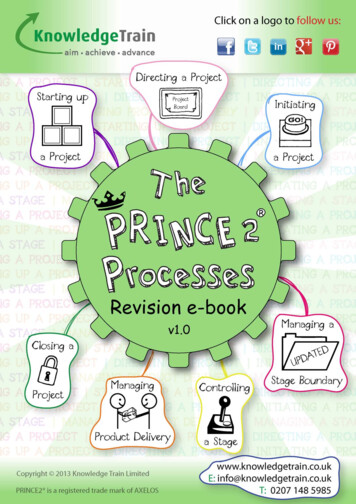

![Managing successful projects with PRINCE2 [PDF] 6th ed.,](/img/18/1-principles.jpg)
